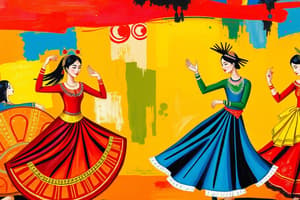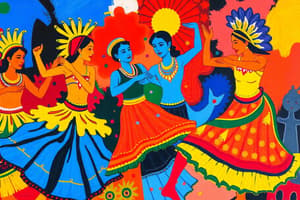Podcast
Questions and Answers
Which of the following best describes Philippine folk dances?
Which of the following best describes Philippine folk dances?
- Dances that are created by professional dancers
- Dances that are performed only on special occasions
- Dances that are influenced by foreign cultures
- Dances that evolved naturally from everyday activities (correct)
Who is considered the mother of Philippine folk dances?
Who is considered the mother of Philippine folk dances?
- A famous Filipino dancer
- Francisca Reyes Aquino (correct)
- A national artist of the Philippines
- A collector of traditional dances
How are Philippine folk dances categorized?
How are Philippine folk dances categorized?
- By their popularity among the Filipino people
- By their religious or ceremonial significance
- By their ethnic or Christian origin (correct)
- By their connection to everyday activities
What do national dances represent?
What do national dances represent?
What are religious or ceremonial dances called in the Philippines?
What are religious or ceremonial dances called in the Philippines?
Which of the following is NOT a category of Philippine folk dances?
Which of the following is NOT a category of Philippine folk dances?
Who is considered the founder of the collection of Philippine dances and songs?
Who is considered the founder of the collection of Philippine dances and songs?
What is the significance of folk dances in Filipino culture and arts?
What is the significance of folk dances in Filipino culture and arts?
What are Philippine folk dances evolved naturally and spontaneously in connection with?
What are Philippine folk dances evolved naturally and spontaneously in connection with?
What is the purpose of comic dances in the Philippines?
What is the purpose of comic dances in the Philippines?
Flashcards are hidden until you start studying
Study Notes
Introduction to Philippine Folk Dances
- Philippine folk dances are traditional dances that have evolved naturally and spontaneously in connection with everyday activities and experiences of the people.
- Folk dancing is a popular form of recreation enjoyed by everyone and is an integral part of Filipino culture and arts.
- Francisca Reyes Aquino, a National artist of the Philippines, is considered the mother of Philippine folk dances and started collecting dances and songs as early as 1924.
- Philippine folk dances can be categorized into non-Christian or ethnic dances and Christian dances.
- Ethnic dances are known for their innate, unique, and beautiful movements.
- National dances represent specific countries, while local dances represent specific localities within the Philippines.
- Occupational dances depict the passion and activities of certain occupations.
- Religious or ceremonial dances, such as the doxology, are performed for religious or ceremonial purposes.
- Comic dances are characterized by funny or entertaining movements.
- Philippine folk dances have different themes and are performed for various occasions, including weddings, festivals, wars, and victories.
- These dances are a reflection of the rich cultural heritage of the Philippines.
- Folk dancing is a wholesome form of recreation that is enjoyed by people of all ages and backgrounds in the Philippines.
Studying That Suits You
Use AI to generate personalized quizzes and flashcards to suit your learning preferences.




